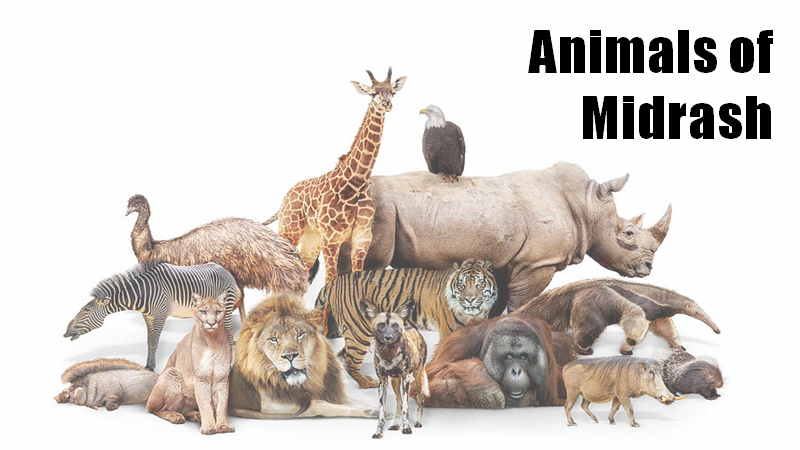The (mostly) Animal Stages of Life
In this short Midrash, Rabbi Shumel in the name of Shimon ben Elazar describes the various stages of human life as (mostly) likened to different animals (King, Pig, Kid Goat, Horse, Donkey, Dog, Monkey). And while the teaching appears fairly clear, there are some nuances in the reading which may allow for an extended interpretation of the passage or even an expansion of the entire concept. For example, the Midrash describes the unmarried individual as a horse and the married individual as a donkey. This image may contrast the subdued donkey and the wild horse in order to demonstrate the need for commitment and fidelity in the marriage. Possibly the reference of marriage/donkey refers to the stubbornness often expressed in the context of married relationships. A further reading may insist that the metaphor of unmarried-horse and married-donkey are solely images to express the change in the unmarried/married man, and a different metaphor is needed to express the change in the unmarried/married woman.
In the postscript - representing the view of a different (annonymous) rabbinic author, or of Rabbi Shumel himself - the teaching is interpreted to only apply to ordinary Jewish people and not to Torah scholars. However, it is unclear if the later comment wishes to argue that the scholar is like a king from cradle to grave, or if they will concede that at least the early stages (e.g., the toddler/pig stage) will apply to such a person.
רַבִּי שְׁמוּאֵל בַּר רַב יִצְחָק מַתְנֵי לָהּ בְּשֵׁם רַבִּי שִׁמְעוֹן בֶּן אֶלְעָזָר,
שִׁבְעָה הֲבָלִים שֶׁאָמַר קֹהֶלֶת כְּנֶגֶד שִׁבְעָה עוֹלָמוֹת שֶׁאָדָם רוֹאֶה,
- בֶּן שָׁנָה דּוֹמֶה לְמֶלֶךְ נָתוּן בְּאִיסְפְּקַרְפַּסְטִי וְהַכֹּל מְחַבְּקִין וּמְנַשְּׁקִין אוֹתוֹ,
- בֶּן שְׁתַּיִם וְשָׁלשׁ דּוֹמֶה לַחֲזִיר שֶׁפּוֹשֵׁט יָדָיו בְּבִיבִין.
- בֶּן עֶשֶׂר שָׁנָה קוֹפֵץ כִּגְדִי.
- בֶּן עֶשְׂרִים כְּסוּס נָהֵים מְשַׁפַּר גַּרְמֵיהּ וּבָעֵי אִתְּתָא.
- נָשָׂא אִשָּׁה הֲרֵי הוּא כַּחֲמוֹר.
- הוֹלִיד בָּנִים מֵעֵז פָּנָיו כְּכֶלֶב לְהָבִיא לֶחֶם [נסח אחר: להם] וּמְזוֹנוֹת.
- הִזְקִין, הֲרֵי הוּא כְּקוֹף.
הֲדָא דְּתֵימַר בְּעַמֵּי הָאָרֶץ, אֲבָל בִּבְנֵי תוֹרָה כְּתִיב (מלכים א א, א): וְהַמֶּלֶךְ דָּוִד זָקֵן, אַף עַל פִּי שֶׁהוּא זָקֵן, מֶלֶךְ.
(Adapted translation) - Rabbi Shmuel son of Rabbi Yitzchak taught in the name of Rabbi Shimon son of Elazar:
"The seven follies which Kohelet declares refer to the seven worlds the human sees:
- [The first]: At age one, like a monarch. The child is placed in a chariot and everyone hugs and kisses them.
- [The second]: At age two and three, like a pig. As they place their hands in dirt.
- [The third]: At age ten, the child jumps around like a kid goat.
- [The fourth]: At age twenty, like a horse. They growl and preen and they seek a mate.
- [The fith]: At marriage, like a donkey.
- [The sixth]: At parenthood, like a dog. They act brazenly to find their children food and sustenance.
- [The seventh]: At old age, like a monkey.
[Postscript]: This teaching refers to the lives of ordinary people, but not so for the Children of Torah. As it is written "And King David was old" (Kings I, 1:1), meaning, even though he was old, he was still a king.




